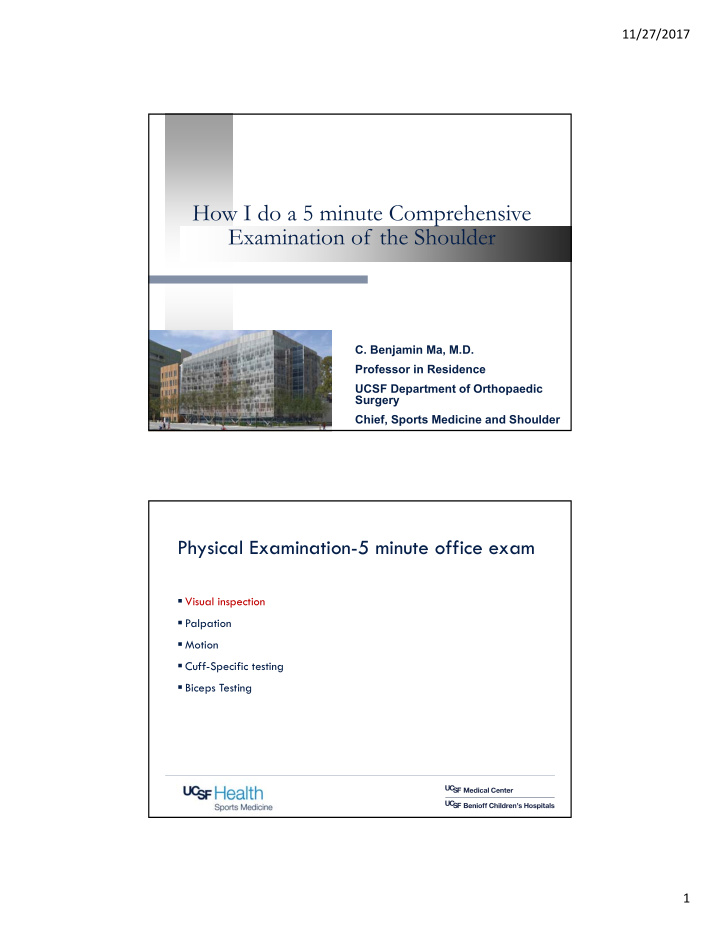



11/27/2017 How I do a 5 minute Comprehensive Examination of the Shoulder C. Benjamin Ma, M.D. Professor in Residence UCSF Department of Orthopaedic Surgery Chief, Sports Medicine and Shoulder Physical Examination-5 minute office exam Visual inspection Palpation Motion Cuff-Specific testing Biceps Testing 1
11/27/2017 Shoulder examination Inspection • Patient in gown Palpation ROM Strength • Supraspinatus • Infraspinatus & Teres minor • Subscapularis • Biceps Other tests Visual Inspection Remove shirt Systematic • Deltoid • Supraspinatus • Infraspinatus • Biceps • AC joint • Skin changes • Scars 2
11/27/2017 Shoulder examination Inspection Palpation ROM Strength • Supraspinatus • Infraspinatus & Teres minor • Subscapularis • Biceps Other tests Palpation Press where it hurts Location Diagnosis Clavicle Clavicle fracture AC joint AC joint arthritis Trapezius/Neck Muscle strain Front of shoulder Biceps pathology Back of shoulder Arthritis 3
11/27/2017 RANGE OF MOTION No arthritis No arthritis No problem No problem No cuff tear No cuff tear With AROM With AROM No frozen shoulder No frozen shoulder Active Range of Motion Active Range of Motion “What can you do?” “What can you do?” No problem with passive No problem with passive Think CUFF TEAR Think CUFF TEAR Difficulty with active Difficulty with active -check passive -check passive Problem with passive Problem with passive Think Shoulder OA or Think Shoulder OA or Frozen Shoulder Frozen Shoulder Rotator Cuff Testing Im pingem ent --Neer ’ s/ Hawkins tests Muscle Strength --Teres Minor --Infraspinatus --Supraspinatus --Subscapularis 4
11/27/2017 Pain test: Painful arc If painful, positive LR 3.7 for RCD. If not painful, negative LR 0.36 for RCD. JAMA. Rational clinical exam: Does this patient have rotator cuff disease? Aug 2013. Pain test: Impingement signs Hawkin’s Neer’s Photos from Dr. Christina Allen 5
11/27/2017 Rotator Cuff Impingement Hawkins’ Test • 75% sensitive • 49% specific Neer’s Test • 85% sensitive • 44% specific Park, et al. JBJS 2012 Supraspinatus Jobe’s test 30° • 90º abduction • 30º anterior flexion • Internal rotation (palms down) • Pain/weakness • 53% sensitive/82% spec. • (Park, et al. JBJS 12) 6
11/27/2017 Infraspinatus External rotation strength 0º abduction & 45º ER Infraspinatus Pain/strength test: Drop arm test Positive LR 3.3, negative LR 0.82 for rotator cuff disease. JAMA. Rational clinical exam: Does this patient have rotator cuff disease? Aug 2013. 7
11/27/2017 Subscapularis Lift off test Bear Hug test About 70% reliable About 70% reliable (JAMA 2013) (JAMA 2013) Pain & Strength test: Subscapularis = internal rotation lag test aka ‘lift off’ Positive LR 5.6, negative LR 0.04 for full thickness rotator cuff tear. JAMA. Rational clinical exam: Does this patient have rotator cuff disease? Aug 2013. 8
11/27/2017 Biceps Bicipital Tendonitis • TTP at biceps groove ‒ Compare to other side AC arthritis Pain with palpation Pain with cross chest adduction tests Pain located at the AC joint 9
11/27/2017 Superior Labrum Anterior Posterior Lesion O ’ Brien ’ s Test Adduction 15-20 deg Forward Flexion 90 deg Thumbs down Resisted forward flexion Positive test only when: • Pain with the above position • Pain diminishes when palm is supinated • Otherwise equivocal test Superior Labrum Anterior Posterior Lesion SLAP lesion is a disease of the young individual Sensitive test Not a specific test • Labral pathology • Rotator cuff tendon tears 10
11/27/2017 Stability examination Translational tests • Anterior translation • Posterior translation • Inferior translation Grading • I – to the rim not over • II – over the rim but spontaneously reduce • III – locked dislocation Load and Shift test Slight joint compression Anterior / posterior translation Inferior pull for sulcus sign Relax patient 11
11/27/2017 Instability tests Apprehension sign • Arm 90 deg abducted, 90 deg external rotation • Dislocation position for anterior instability Relocation sign • Relieve of pain with a posteriorly directed force ‘ Jerk ’ sign • Posteriorly directed force of the shoulder • Pain with posterior instability Physical examination Examine the cervical spine • Referred pain!! • Range of motion • Strength Examine distal motor strength • Peripheral nerve examination Remember zebras • Pain out of proportion ‒ Lung CA – Pancoast tumor 12
11/27/2017 Thank you C. Benjamin Ma, M.D. Professor in Residence UCSF Department of Orthopaedic Surgery Chief, Sports Medicine and Shoulder (415) 353-7566 maben@ucsf.edu 13
Recommend
More recommend